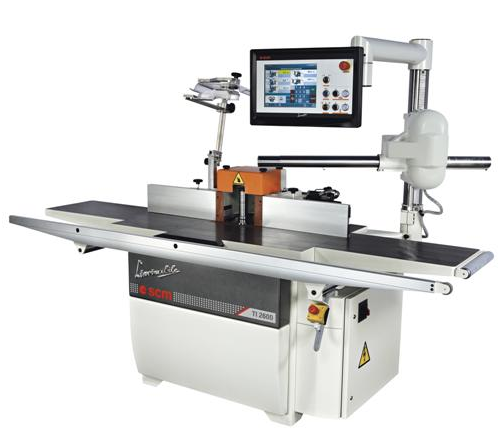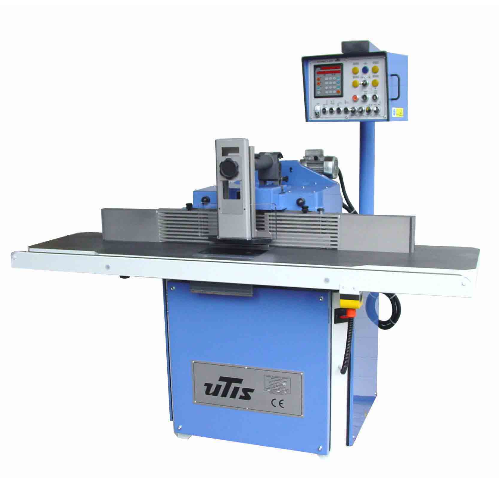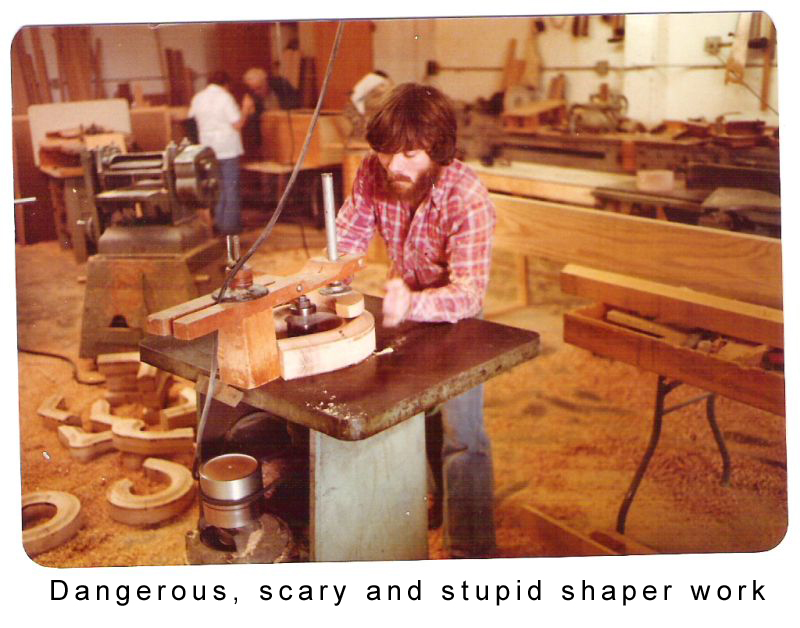Upgrading Shapers: One High-End Machine, or Several Cheaper Ones?
Here's a long, detailed, and thoughtful thread with lots of first-hand stories, about the choice between using one top-end shaper for everything, or setting up four cheaper ones for dedicated tasks. June 22, 2012
Question
I will soon be upgrading all my shapers to 1.25" insert cutters and need to upgrade the shapers as well (lack of hp and only 3/4" bore). Do you feel itís a better idea to buy one high end $15,000-$20,000 dollar shaper with quick change collets vs. much less expensive machines. I am looking at the SCM T130 class or similar with many added features.
Forum Responses
(Solid Wood Machining Forum)
From contributor K:
What are your needs for the shaper? Do you build a lot of frame and panel products or do you mostly run moldings? In my business I built all of my own frame and panel cabinet doors as well as integral F&P end panels, wall paneling, etc. The focus of my business was to build all my own product so I had four dedicated shapers, each set up for one function of machining F&P work.
From the original questioner:
I am in the same situation. I build all of my own cabinet doors, as well as frame and panel cabinet sides, wainscoting, etc. I like all the bells and whistles that come on the high end machines and the tight tolerances that they are machined to. I currently use four shapers set up for independent tasks which works fine. I was just wondering if anyone out there uses one good shaper for all three main tasks (cope, stick, panel raise) with quick change spindles; and if it is as efficient as dedicated machines. Shop space isn't a factor.
From contributor B:
They are certainly not cheap, but having four or five dedicated Weaver shapers is tough to beat if you are just doing cabinet doors. The tractor feed and variable speed feeders are great. The way the fences are set up and the air clamping make quick work of doors. However I would not want to change cutters out on a regular basis.
From contributor O:
I think it depends a lot on your product. If you only do cabinet doors with one or two profiles, the dedicated route works pretty well. Way back, we had dedicated shapers for cabinet doors and one heavy EMA shaper for house doors and millwork. This worked pretty well as long as we could keep them set up for one job. As the shop became busier the dedicated machines were changed over a lot, and as Contributor B pointed out that is not ideal on a standard shaper. About ten years ago we bought a numeric control Martin shaper. After a while the other shapers did not get much use and we sold them off. Since then we have evolved to adding a numeric tenoner, a Felder shaper, and a numeric profiler that I am rebuilding. The one Martin shaper could still handle all of our profiling. The other machines are nice when a couple jobs are in progress with the usual one-offís. All numeric shapers on the market are not created equal. I would look close before you buy.
As I said it depends on the product. We do doors, windows, and a lot of custom architectural millwork. In any given month we could have 30 or more different setups several times so this system works for us. The pros of a high end shaper are the cut quality (which will be better than a standard machine), the repeatable accuracy, and the versatility. The con is slightly longer setup than just walking up to a dedicated machine, and the operator must have some technical skills and a feel for operating a numeric shaper. Itís not a machine you would let everyone in the shop set up. For cabinet doors the machines Unique and other companies make are worth looking at. I have no experience with those but they might be the deal for cabinet doors.
From contributor U:
I use to have a few low dollar dedicated shapers, and then decided to buy a new SCMI T130. I love that shaper. The repeatability and cut quality is great, and it's now the only shaper I use for everything. You will receive different opinions, but that's my experience.
From the original questioner:
Thanks for all the feedback. I am still torn on the subject. I am leaning towards a higher end shaper but probably not CNC controlled. I am for the most part running stile and rail cutters and large panel raisers in a variety of profiles of each. I do have several other molding cutters, but rarely if ever set them up and use them. I don't want a unique or e-z door because of the size and use limitations. I am just concerned that it will still be a little bit of a pain to change operations and get everything back to perfect in a timely manner without going all the way to a CNC controlled shaper. Am I wrong?
From contributor U:
One thing to remember is the setup and changeover is a lot quicker and more accurate on a high end shaper. You can stack cutters on a big shaper, plus the benefit of numerical readout for the spindle and fence make setups fast and easy. I have all of my setups written down on a chart, so I just refer to those everytime and don't have to waste time running test pieces.
From the original questioner:
Well that does it, I will go with a high end shaper. Every shop could use a little more eye candy. Any recommendations on brands and must-have features? I know Martin was mentioned earlier, that is probably out of my price range. I had been looking more in the SCM line as they offer a side mount tennoning table that I thought would be great to for coping . Does anyone have or recommend that feature?
Also, I like the look of the long infeed and outfeed beds with roller bars but I just can't find a practical need for that much support for my applications (mainly cab doors). Am I overlooking a benefit to those massive tables (other than looks)? Are there any other little things that you have found through the years or research that you love or couldn't work without now that I should consider adding or trying to find a machine that offers?
From contributor O:
A shaper with an accurate mechanical digital readout fence (Seco type) would be almost as good as the motorized fence. Like Contributor U says, you just keep setup sheets close with all of your settings. The electronic height setting shaft is nice and don't think I would want to be without that. One thing to look for in electronic shapers is if the spindle and fence can be moved in .1mm increments. The Martin does this for both fence and spindle but the Felder Shaper and Colombo tenoner will not do this in the shaft and I have found it to be a pain. Numeric setting machines are not a perfect world especially if you have dirty power like we do. You have to keep an eye on them. Easy calibration is another important feature to look for in a new machine. If I could do it over I would run my shop with one of these new digital phase converters.
I have some extra quick change shafts for the Martin but itís only a few seconds longer to pop the nut and change the cutter. Again, it depends on your production. A dedicated shaft for every cutter we use would not pencil out. We stack a lot also. You mentioned that you are purchasing new tooling. You should be able to get this with constant diameter cutting circles and height which will make setup easier.
One thing you will find with a shaper like this is you will use it for a lot more than door cuts. We used to keep a unisaw for dado and rebating cuts but have found the shaper with adjustable groovers and rebate heads to be far superior and safer. The side mount slider is the best setup for shapers especially if you are doing architectural and house door - window work.
The problem with the side mount table on a numeric shaper is it is a bit of a change over. The fence either has to be turned or swung back with a tenon hood installed and the table raised up and over the cast table. On the Martin this takes five minutes plus. SCM has a couple grades of side mount tables with the top end model a good unit. We used the Martin for several years with the small bolt on sliding table. This worked fine for cabinet door cuts but it was not ideal for long heavy work. In the end two good shapers, one for end cuts and one for profiling is the best setup for a small shop.
The long built in extension tables are nice and we are also set up with Aigner quick connect extension tables for really long work. European shapers are designed with these and the pull out extension bar in front of the machine for doing outside profiling on assembled doors and windows. Not necessary for cabinet doors but great when you need them.
From contributor T:
I bought what is in the picture below. We paid about 23K sterling for it less than two years ago. It looks very nice on the outside and that is all I can say for it. For 28K I could have had a Martin of similar specification. I regret not buying the Martin.

Click here for higher quality, full size image
From contributor B:
That seems like it would be a great shaper. What is it that you donít like about the machine?
From the original questioner:
Contributor O - thanks for all the insight and detailed posts. Contributor T - the shaper that is shown is basically what I was looking at minus the touch screen, and add the side tenonning table. I am a little concerned that you are unhappy with its performance. Can you elaborate? I understand that the Martin is probably top end as far as performance but spending 30K for one shaper plus tooling is a little far for me. I was thinking around 20K. When it gets up in the 30K range I can buy four nice shapers and set upís dedicated to each machine.
From contributor O:
I have no experience with these other than watching a demo of one at a show in Italy. I was just pointing out that electronic control is not without faults. We have seven machines in our shop with various electronic shafts, beds, and fences. They all go out of calibration slightly on occasion - some almost never, and some on a regular basis. As I said, itís probably due to our dirty power for the most part. You develop a feel for this. If the machine is easy to recalibrate it is no problem. One other thing that makes a shaper truly quick during changeover is a motorized power feed adjustment. Both Martin and SCM offer this. We have this on the Martin and compared to a manual adjusting feeder the setup reduction is considerable.
From contributor T:
I saw this shaper at a show as pictured below. It looked very well built and I managed to speak to an owner of one. He praised it for being reliable and problem free. Notice the system of fence bridging. It is the same fence bridging that Martin uses.

Click here for higher quality, full size image
From the original questioner:
I am thinking that maybe setup wise it would be smarter to go with two separate decent machines. Although that puts me budget wise in two 10K shapers, any thoughts on a solid shaper one sliding, and one traditional feeder setup for about 10K each? I see there are ton of companies out there that I hadn't heard of or tried, but am open to other brands if they have a good track record.
From contributor T:
To the original questioner: You say quality. This is not what I've experienced with my shaper. One of the hinges that goes on the spindle/tool cover snapped in two because it was made from some low strength alloy. I had to replace it with an ordinary steel door hinge which works fine now. Within three months of use we rounded the threads on the knob that locks the fence into place, by hand. We had to have some replacements specially made. There would be no point in ordering some replacements from the manufacturer if they would be just as bad.
From contributor R:
Like Contributor O mentioned, I do have a pair of Class shapers in use for cabinet door production. One is numeric control spindle and fence, and the other just has the fast change spindles. We have about 15 spindles with cutters installed, and about ten are multiple cutters stacked. With constant minor diameter tooling for cope and stick, our profile changes are 30 seconds or so. For the most part, I have been happy with them. I had a motor brake component fail on one, and a controller module fail on the other. Beyond that, they have remained precise and trouble-free. Previously, I had six shapers with stack tooling semi-permanently installed: two for panels and edges, two for coping, and two for sticking. The main advantage for me was gaining floor space by combining functions into the two shapers that we have now.
From the original questioner:
In your opinion is it worth the extra money for the numerically controlled spindle and fence vs. a straight fast change spindle? Also, could you do everything with one shaper, or do you feel it is necessary to have a pair? Are there any brands other than those mentioned that you have and like or can recommend to contact? My budget is around 20k and I think I am at that point where I could get a couple of ok machines.
From contributor R:
The numerical control is one of those things that you can do without, but once you use it for a while, it is hard to imagine going back to manual. We used to have setup signs with spindle height settings for each cut, with digital height gauges. For fence settings, we either used plastic setup blocks (wood changes dimension enough to be annoying), or added auxiliary fence plates of varying thickness to a fence that never moved depending on the machine and how it was used.
If I were going to use a single shaper to do everything, I would want the controller. Either the correct program is displayed or it isn't. There is nothing to forget to adjust, and no fine tuning. One caveat though - for some settings, it takes longer to use a controller. The SCMI, for example, moves the fence out before adjusting spindle height to prevent crashes. This means that you have to move the power feeder out of the way. I kept an eye out for good used machines, so I have maybe $25K invested between the two shapers and all of the spindles.
From contributor T:
Before I bought my SCM shaper, I fought tooth and nail to convince my colleagues that a numerical control shaper was the way to go. At the time we had a 20 plus year old Wadkin shaper with no readouts of any kind. My colleagues couldn't imagine using anything else. Eventually, through many discussions, I acquire my SCM shaper. After a year of troubles with it, I was more than ready to get a new one. I suggested to my colleagues to look at getting a less expensive, non-numerical shaper and they point blank refused. They said they loved bringing up the programs and wouldn't go back, not even to a shaper with digital readouts. I couldn't believe what I was hearing. I had to force the numerical control upon them and now they couldn't do without it.
The software on the Martin controller is more user friendly in my opinion. On my SCM controller screen we have to try and double click the program names with our nails to select them, which is a bit fiddly because the program names are packed so close together. On the Martin controller screen the operator can use his fingers to select programs. I actually attached a keyboard and mouse to our controller to alleviate this problem.


